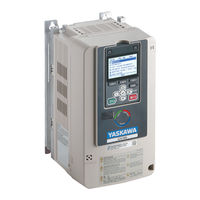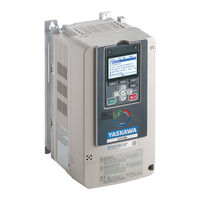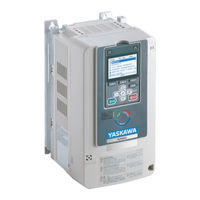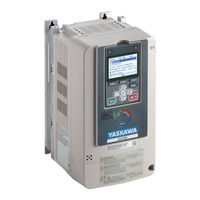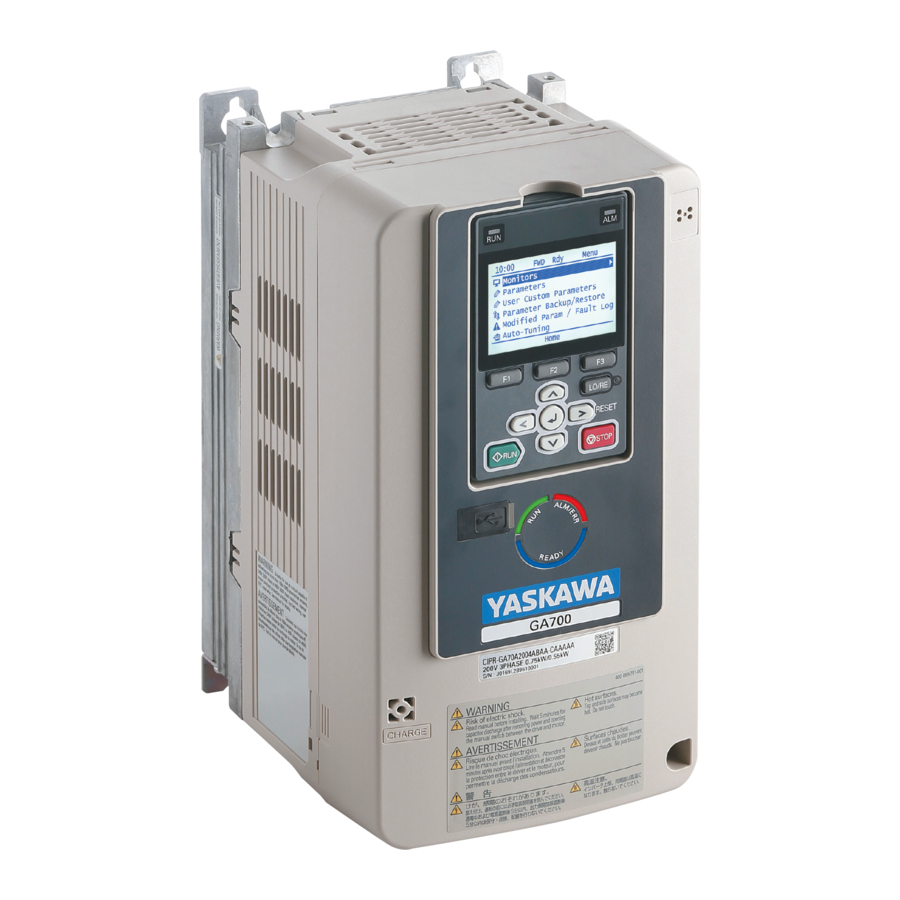
YASKAWA GA700 Manuals
Manuals and User Guides for YASKAWA GA700. We have 7 YASKAWA GA700 manuals available for free PDF download: Technical Manual, Installation Manual, Initial Steps
YASKAWA GA700, GA800, CH700, CR700, LA700, ES700 Manual
Brand: YASKAWA
|
Category: CD/CDR Drive
|
Size: 4 MB
Table of Contents
Advertisement
YASKAWA GA700 Technical Manual (1053 pages)
Table of Contents
-
1 Receiving
19 -
-
Decrease Noise127
-
Wiring Checklist133
-
-
LED Status Ring147
-
Keypad Operation155
-
Set Data to Log184
-
Auto-Tuning192
-
Test Run202
-
-
-
General Safety220
-
UL Standards256
-
对应中国Rohs指令283
-
本产品中含有有害物质的信息283
-
-
-
-
-
Message Format295
-
Enter Command302
-
Self-Diagnostics303
-
Error Codes325
-
-
General Safety328
-
Faults337
-
-
Command393
-
Energized394
-
PID Output Fault395
-
YASKAWA GA700 Technical Manual (1021 pages)
AC Drive for Industrial Applications
Brand: YASKAWA
|
Category: Industrial Equipment
|
Size: 81 MB
Table of Contents
-
Receiving14
-
Glossary14
-
Receiving21
-
Nameplate23
-
Class39
-
Class40
-
Drive Ready109
-
(Rcm/Rcd)118
-
Decrease Noise123
-
Wiring Checklist128
-
Section Safety134
-
LCD Display136
-
LED Status Ring141
-
Keypad Operation149
-
Show the Monitor150
-
Presets)184
-
Auto-Tuning186
-
Control Tuning190
-
Test Run195
-
Load Test Run195
-
Section Safety208
-
EMC Directive231
-
UL Standards241
-
Area of Use241
-
对应中国Rohs指令267
-
本产品中含有有害物质的信息267
-
Notes269
-
Section Safety276
-
Message Format281
-
Enter Command287
-
Self-Diagnostics288
-
Error Codes309
-
Troubleshooting311
-
Section Safety312
-
Fault320
-
Fault Reset372
-
Typical Problems373
-
Command377
-
Drive378
-
PID Output Fault379
-
Section Safety382
Advertisement
YASKAWA GA700 Technical Manual (936 pages)
High Performance Type; 200 V class: 0.4 to 110 kW; 400 V class: 0.4 to 355 kW
Brand: YASKAWA
|
Category: Controller
|
Size: 29 MB
Table of Contents
-
-
Receiving14
-
-
1 Receiving
19-
Receiving21
-
-
Transport32
-
-
Keypad107
-
LED Status Ring113
-
Keypad Operation122
-
Show the Monitor123
-
Set Data to Log146
-
Auto-Tuning153
-
Test Run161
-
-
-
UL Standards203
-
-
Specification224
-
Notes225
-
-
-
-
Message Format235
-
Enter Command238
-
Self-Diagnostics239
-
Error Code261
-
-
Fault273
-
-
Motor Is too Hot325
-
Command327
-
PID Output Fault330
-
Sound from Motor331
YASKAWA GA700 Installation Manual (186 pages)
IP55/UL Type 12 Heatsink External Mounting
Brand: YASKAWA
|
Category: Servo Drives
|
Size: 42 MB
Table of Contents
-
English9
-
Overview9
-
Safety9
-
Receiving11
-
Installation15
-
Deutsch25
-
Übersicht25
-
Sicherheit26
-
Installation33
-
Français44
-
Sécurité44
-
Réception47
-
Italiano62
-
Panoramica62
-
Sicurezza62
-
Ricezione65
-
Español80
-
Seguridad80
-
Recepción83
YASKAWA GA700 Initial Steps (33 pages)
High Performance Type
Brand: YASKAWA
|
Category: Controller
|
Size: 7 MB
Table of Contents
-
Setup Wizard22
-
Auto Tuning23
YASKAWA GA700 Installation Manual (28 pages)
AC Drive
Brand: YASKAWA
|
Category: CD/CDR Drive
|
Size: 4 MB
Table of Contents
Advertisement
